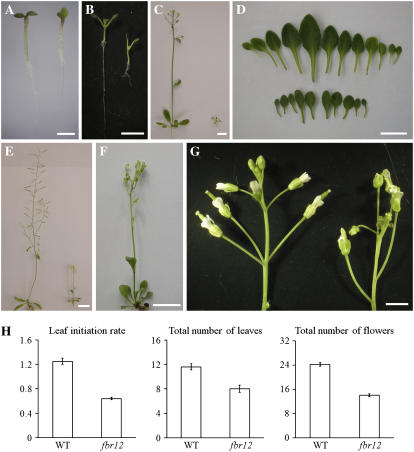Figure 2.
Defective growth and development in fbr12. A, Four-day-old seedlings of wild type (Ws; left) and fbr12 (right) germinated and grown in Murashige and Skoog medium under continuous white light. No substantial difference between wild type and fbr12 is observed at this stage. Bar = 1 mm. B, Ten-day-old seedlings of wild type (Ws; left) and fbr12 (right) germinated and grown in Murashige and Skoog medium under continuous white light. Bar = 5 mm. C, Four-week-old plants of wild type (Ws; left) and fbr12 (right) germinated and grown in soil under continuous white light. Bar = 5 mm. D, Rosette leaves collected from 4-week-old plants of wild type (Ws; top) and fbr12 (bottom) germinated and grown in soil under continuous white light. Bar = 5 mm. E, Seven-week-old plants of wild type (Ws; left) and fbr12 (right) germinated and grown in soil under continuous white light. Bar = 2 cm. F, Enlarged view of an fbr12 plant shown in E. The plant was germinated and grown in soil under continuous white light for approximately 7 weeks. Bar = 2 cm. G, Comparison of wild-type (left) and fbr12 (right) floral inflorescences derived from 6-week-old plants germinated and grown in soil under continuous white light. Bar = 2 mm. H, Analysis of growth rates of adult organs of wild-type and fbr12 plants germinated and grown in soil under continuous white light. Leaf initiation rate was calculated as the number of new leaves produced per day between the second and the seventh true leaves. Total number of leaves refers to rosette leaves 40 d after germination. Total number of flowers refers to flowers at stage 12 and above (flower development stages are defined according to Sanders et al. [1999]). At least 30 plants were analyzed in each experiment and average values were shown. Bars = ses.

